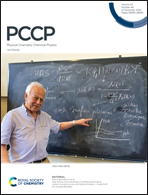Induced circular dichroism of achiral dielectric elliptical hole arrays with a monolayer borophene film
Abstract
Induced circular dichroism (ICD) is widely used in miniature polarizers, molecular detection, and negative refractive index media. However, enhancing and the dynamic regulation of ICD signals of achiral nanostructures in the visible and near-infrared range remain the current challenges. Here, monolayer borophene (MB) with anisotropic conductance was incorporated into achiral nanostructures, which consisted of achiral dielectric elliptical hole arrays (DENAs) placed on a silver substrate. Two narrowband ICD signals for DENAs/MB were achieved in the near-infrared range under different circularly polarized lights. The distributions of the magnetic field of DENAs/MB could explain the two narrowband ICD signals originating from the coupling of surface plasmon polariton resonances along the x- and y directions. Not only could the ICD signals be tuned by the structural parameters of DENAs/MB, but they could also be actively tuned by the incident angles of the excitation light and the carrier concentration of MB. In addition, the sensitivity and the figure of merit of DENAs/MB could reach 302/RIU and 61.0. These results provide a concise method for the design of dynamically adjustable chiral devices based on borophene and promote its application in molecular recognition and chiral catalysis.



 Please wait while we load your content...
Please wait while we load your content...